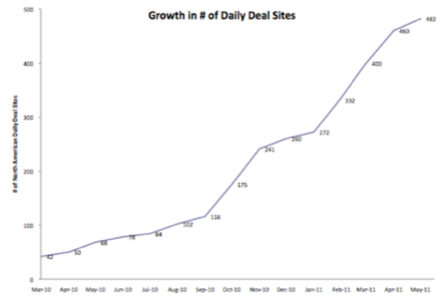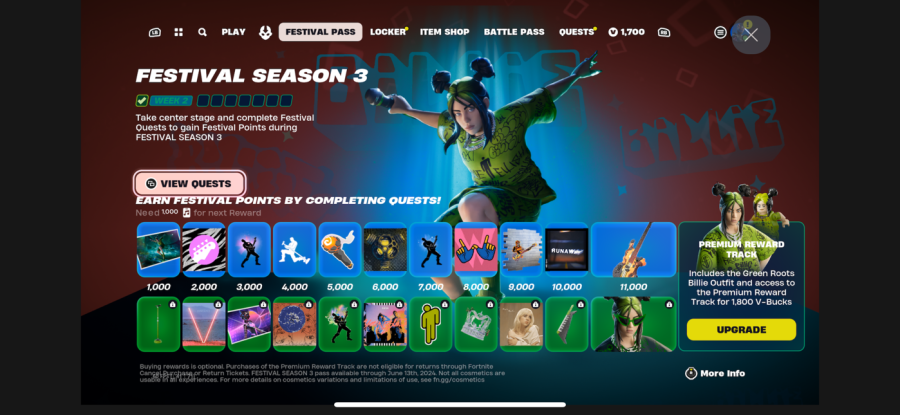
The number of daily deal sites is growing at an amazing rate. Recent data from daily deal aggregator Yipit, shows there are now over 480. The number has grown by almost a factor of 10 over the last year (chart below).
Entrepreneurs definitely have become interested in this model. The largest, Groupon, is actually being studied by some leading academic researchers. We thought it’d be worth summarizing five interesting observations from this research.


Summary of Research being Referenced
Early research was done by Dr. Utpal Dholakia at Rice University. He published a paper summarizing a survey he completed of 150 different businesses.
“The promotion was profitable for 66% and unprofitable for 32% of respondents. When compared to businesses with profitable Groupon promotions, those with unprofitable promotions reported significantly lower rates of both spending by Groupon users beyond it’s face value (25% vs. 50%) and return rates to purchases from the business again at full prices (13% vs 31%)”
Interestingly,82% of those who found it ‘unprofitable’ some will run another Groupon again. This is closer to (but still lower than) Groupon’s internal number of 97% of Groupon merchants who ask to run a campaign again.
Based on this research, Dr. Dholakia and a group of researchers at Harvard have both written papers further examining this issue of profitability. I’d encourage you to read both Dholakia’s recent paper “What Makes Groupon Promotions Profitable For Business?” and The Harvard Business School working paper by Edelman, Jaffe and Kominers, “To Groupon or Not to Groupon: The Profitability of Deep Discounts”
The HBS Working Paper focuses on building out a model that explores how “consumer demographics and offer details interact to shape the profitability of voucher discounts.” The paper by Dr. Dholakia explores 5 hypothesis and tests them using a linear regression against the 150 data points from his original survey mentioned above. He does acknowledge that the 150 business’s who respond form a “convenience sample” and therefore may have limitations but he also points out that it’s diverse across the Groupon client base and a “41.7% response rate can be characterized as ‘healthy’ and in line with published research.”

5 Observations
Getting back to the goal of this post, I’d like to explore 5 interesting observations from both these studies:
Observation 1: Theoretically there are two benefits for retailers doing daily deals offers
The HBS paper opens by exploring two benefits of Groupon like offers for retailers:
“First, discount vouchers can facilitate price discrimination, allowing merchants to offer distinct prices to different consumer populations. In order for voucher
offers to yield profitable price discrimination, the consumers who are offered the voucher discounts must be more price-sensitive (with regards to participating merchants’ goods or services) than the population as a whole. Second, discount vouchers can benefit merchants through advertising, by informing consumers of a merchant’s existence. For these advertising effects to be important, a merchant must begin with sufficiently low recognition among prospective consumers.”
Observation 2: Spending beyond face value at redemption is not predictive of profitability
Dr. Dholakia tested 3 hypotheses for attributes that would increase the likelihood of a profitable Groupon: “A) New customer acquisition efficacy, (B) spending beyond the Groupon’s face value, and (C) repeat full-price purchase.” Interestingly, the first and third factors were predictive but the second was not. He explains:
“It appears that for firms running a Groupon promotion, simply getting new customers to purchase the Groupon even when they do not spend beyond its face value on the occasion of redemption is sufficient to have a profitable promotion. This result supports the importance of the Groupon promotion as a means for the small or medium-sized business to receive exposure in a new customer base.”
Observation 3: A larger face value & redemption duration helps attract new customers but the discount does not
Based again on Dr. Dholakia’s survey data, it appears that while face value and redemption duration are important to attracting new customers the amount of the discount didn’t appear significant. As the paper states:
“The results offer interesting practical guidance to firms suggesting that they may be better served offering a coupon with a higher face value but a lower depth of discount to garner a profitable Groupon promotion.”
Observation 4: If possible, don’t allow using multiple vouchers

The HBS model explores the impact of allowing customers to purchase multiple vouchers. While this certainly doesn’t immediately cause a Groupon offer to become unprofitable, as the model shows it’s ideal to not allow the use of multiple vouchers at the same time. While this may be difficult to police, definitely something worth striving for and something new initiatives (like Google Wallet and Offers) should take into consideration as a design goal.
Observation 5: Repeat Customers Driven by Employee Satisfaction
One of the most interesting hypothesis tested by Dr. Dholakia in my opinion was looking at employee satisfaction with the Groupon as a predictor for customers returning to purchase products at full price. The linear regression showed these attributes to strongly correlated. While there has been plenty of research over the years showing employee satisfaction is predictive of customer satisfaction, it’s interesting to see this carry forward to the implications for the success of Groupon offers.
Future Investigations
It’s clear that there is a lot more research to be done in the ivory towers of academia as entrepreneurs change the way we buy and sell things each day. From an academic perspective, I’d love to see additional quantitative surveys from more retailers and also (as Dr. Dholakia himself acknowledged in his paper) looking at other daily deal sites such as Living Social. What types of questions would you like to see academic researchers explore in this area?
Dubai Shopping Mall photo by Uggboy, SM Mall photo by Jun Acullador, Mall of America photo by Aine D










